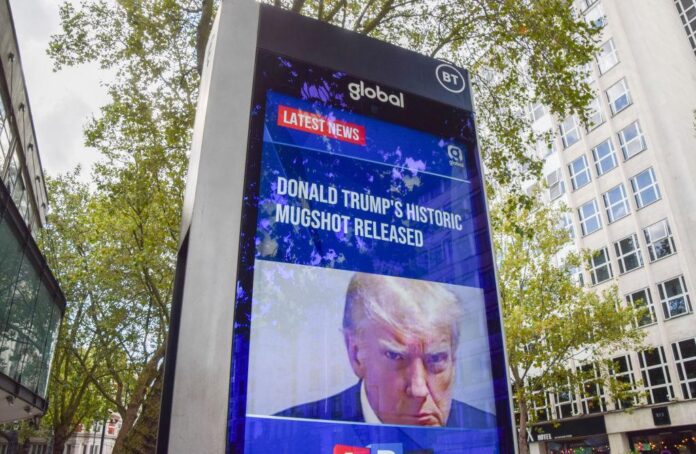You’ve no doubt seen it by now. It is omnipresent. It is on every front page and social media feed. It has been texted, tweeted, printed, pasted. It has been mocked and weaponized, used as a punchline and a rallying cry. It is already a mega-meme and the photo of the year. It is one of the defining images of the 21st century.
Donald Trump’s mug shot—the first ever taken of a U.S. President—is historical. It’s also complicated.
Yesterday, August 24, Trump arrived in Atlanta to be booked on racketeering charges related to his alleged attempts to change the outcome of the 2020 U.S. presidential election in Georgia. During a 20-minute visit to Fulton County Jail, he was booked, fingerprinted, photographed, and released on bail. Police released his mug shot shortly thereafter.
It’s a rich, equivocal image. The 45th President glares at the camera, his face pitched forward, frame right, and cast in the shadow of swooped hair. Below he wears a blue suit and a red tie that draws out the vessels of his eyes. Critics will see the menacing glower of a villain, supporters a look of steely determination. Some will find in it a symbol of justice triumphing over a man who had evaded it for so long; others a metaphor for the modern American political machine: tired, corrupt, sensationalized.
It is also just a typical mug shot. The resolution is low, the lighting is poor. These images, it’s easy to forget, are designed to degrade their subjects. They are unregulated, prejudicial instruments of police punishment.

In this handout provided by the Fulton County Sheriff’s Office, former U.S. President Donald Trump poses for his booking photo at the Fulton County Jail on August 24, 2023 in Atlanta, Georgia.
“Photography has a long-standing relation to policing,” Shawn Michelle Smith, a professor of visual and critical studies at the School of the Art Institute of Chicago, wrote in a 2018 essay for . She pointed out that, just years after the technology was introduced in 1839, American law enforcement offices were displaying gridded photos of arrested suspects—known as rogues’ galleries—in public places.
If the mental image of crowds gathering around criminal portraits in town squares feels like a relic of a bygone era, it also underscores the sense of spectacle baked into these images. And then again, it shouldn’t feel so quaint: Before Trump’s trip to Fulton County Jail, gridded pictures of Rudy Giuliani, Mark Meadows, and other defendants in Georgia’s 19-person racketeering case circulated online to similar effect among gleeful critics and aggrieved supporters.
The mug shot as we know it was developed in the 1880s by Alphonse Bertillon, an anthropologist and chief of the Judicial Identification Service of France. (Early examples exist in the Metropolitan Museum of Art’s permanent collection.) He too saw photography’s potential in policework, but recognized it as an imperfect tool. In Bertillon’s system, photos were always accompanied by a standardized set of biometric information.
Nearly a century and a half later, the basic framework of Bertillon’s system still shapes law enforcement efforts today. But the lessons that got him there haven’t been passed down in the same way, Smith argued. “What the history of the mug shot demonstrates is that such disciplinary ways of looking had to be learned,” she wrote. “They were crafted, standardized, practiced, and taught. There is nothing transparent about these images or the way they present individuals.”
A 2019 exhibition at apexart, called “The Criminal Type,” looked at the mug shot through the history of positivist criminology. The field, developed in the late 19th-century, was predicated on the belief that people were born criminals and thus could be identified before breaking the law. Baked into its logic were then-prevalent notions of biological and moral superiority.
Elizabeth Breiner, the curator (and a member of the group Forensic Architecture) explained in an exhibition’s text that the mug shot is “part of a larger industry that profits off the humiliation and degradation of those who can often least afford it. In both cases, the mug shot’s function as a criminological resource has been tainted by its double-life as a form of public entertainment.”

Former U.S. President Donald Trump’s X post. Photo: Mustafa Ciftci/Anadolu Agency via Getty Images.
This is the ironic lineage into which Trump’s mug shot, and the furor around it, was born. The picture, wrote New York Times critic Vanessa Friedman reminded, “is part of the pageantry of the moment, part of the theater of law. And Mr. Trump is a man who has always understood the power and language of theater. Of putting on a show. Of the way an image can be used for viral communication and opinion-making.”
On Thursday, Trump was given a new line in his arrest record. He was also given an image custom-made for the type of spectacle on which he’s already built a presidential run. The mug shot can be circulated as an image of Trump humbled, humiliated, and brought low, and as an image of Trump the mastermind, brilliantly working the media. But either way, it’s circulating. That’s a win for him.
Trump has already turned his mug shot into a symbol of rebellion. Not long after he was released on bail, the former president took to X (formerly Twitter, where he was banned until last November) and posted the mug shot atop a caption that read, in all caps: “ELECTION INTERFERENCE / NEVER SURRENDER!”
In an interview with NPR today, Pulitzer Prize-winning photographer David Hume Kennerly said the mug “will be the most published photograph ever taken, no doubt.” But should it be?

























